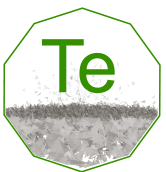Tellurium

Tellurium (Te)
General Information
- Symbol: Te
- Atomic Number: 52
- Atomic Weight: 127.60 u
- Element Category: Metalloid
- Group: 16
- Period: 5
- Block: p-block
Physical Properties
- Appearance: Silvery-white, brittle solid with a metallic luster
- Density: 6.24 g/cm³
- Melting Point: 449.51 °C (841.12 °F)
- Boiling Point: 988 °C (1810 °F)
- Phase at STP: Solid
- Electron Configuration: [Kr] 4d¹⁰ 5s² 5p⁴
- Oxidation States: +6, +4, -2 (most common)
Chemical Properties
- Reactivity: Tellurium is relatively stable in air, but it reacts with halogens and certain acids.
- Compounds: Forms compounds such as tellurium dioxide (TeO₂), telluric acid (H₂TeO₄), and tellurium hexafluoride (TeF₆).
Uses and Applications
- Metallurgy: Used to improve the machinability of copper and stainless steel.
- Electronics: Utilized in semiconductor technology, particularly in cadmium telluride (CdTe) solar cells and thermoelectric devices.
- Alloys: Added to lead to improve its strength and durability, commonly used in batteries.
- Chemistry: Used in chemical synthesis and as a vulcanizing agent in rubber production.
- Glass and Ceramics: Employed to color glass and ceramics and to create optical storage media.
Occurrence and Extraction
- Natural Occurrence: Rare in the Earth’s crust, typically found in ores with other elements such as gold, silver, and copper.
- Extraction: Extracted as a byproduct of copper refining through processes such as electrolytic refining and chemical precipitation.
Isotopes
- Stable Isotopes: Tellurium-120, Tellurium-122, Tellurium-123, Tellurium-124, Tellurium-125, Tellurium-126, Tellurium-128, Tellurium-130
- Radioactive Isotopes: Tellurium-121m, Tellurium-127 (used in scientific research)
Safety and Handling
- Hazards: Tellurium and its compounds are toxic; ingestion or inhalation can cause health issues, including tellurium breath (a garlic-like odor).
- Precautions: Handle with care, using appropriate protective equipment to avoid exposure.
History
- Discovery: Discovered by Franz-Joseph Müller von Reichenstein in 1782.
- Name Origin: Named after the Latin word “tellus,” meaning Earth.
Additional Facts
- Crystal Structure: Hexagonal
- Magnetic Properties: Diamagnetic
- Thermal Conductivity: Low, about 2.35 W/m·K
- Electrical Resistivity: About 1×10⁻³ Ω·m at room temperature
Summary
Tellurium is a metalloid known for its applications in metallurgy, electronics, and chemical synthesis. It is relatively rare and extracted primarily as a byproduct of copper refining. Tellurium has several stable isotopes and is used in various high-tech applications, including solar cells and thermoelectric devices. Due to its toxicity, it must be handled with care.
40 Question and Answer Pairs About Tellurium
What is the atomic number of Tellurium?
- 52
What is the symbol for Tellurium?
- Te
What is the atomic weight of Tellurium?
- 127.60 u
In which group of the periodic table is Tellurium found?
- Group 16
What period is Tellurium in?
- Period 5
What block does Tellurium belong to?
- p-block
What is the melting point of Tellurium?
- 449.51 °C (841.12 °F)
What is the boiling point of Tellurium?
- 988 °C (1810 °F)
What is the density of Tellurium?
- 6.24 g/cm³
What is the electron configuration of Tellurium?
- [Kr] 4d¹⁰ 5s² 5p⁴
What are the common oxidation states of Tellurium?
- +6, +4, -2
What is the appearance of Tellurium?
- Silvery-white, brittle solid with a metallic luster
Is Tellurium reactive with air?
- Relatively stable in air
Name a compound of Tellurium.
- Tellurium dioxide (TeO₂)
What is a common use of Tellurium in metallurgy?
- To improve the machinability of copper and stainless steel
How is Tellurium used in electronics?
- In semiconductor technology, such as cadmium telluride (CdTe) solar cells
What role does Tellurium play in alloys?
- Added to lead to improve strength and durability
How is Tellurium used in chemical synthesis?
- As a vulcanizing agent in rubber production
What application does Tellurium have in glass production?
- Used to color glass and ceramics
Name a mineral that contains Tellurium.
- Often found in ores with gold, silver, and copper
How is Tellurium extracted from ores?
- As a byproduct of copper refining
What is the most stable isotope of Tellurium?
- Tellurium-128
Name a radioactive isotope of Tellurium used in research.
- Tellurium-127
What safety hazard is associated with Tellurium?
- Toxic, can cause health issues
How should Tellurium be handled?
- With care, using appropriate protective equipment
Who discovered Tellurium?
- Franz-Joseph Müller von Reichenstein
Where does the name Tellurium come from?
- From the Latin word “tellus,” meaning Earth
What is the crystal structure of Tellurium?
- Hexagonal
Is Tellurium paramagnetic or diamagnetic?
- Diamagnetic
What is the thermal conductivity of Tellurium?
- About 2.35 W/m·K
What is the electrical resistivity of Tellurium at room temperature?
- About 1×10⁻³ Ω·m
What is the primary oxidation state of Tellurium?
- -2
Is Tellurium found as a free element in nature?
- Rarely, it is usually found in ores
What is the common name of tellurium hexafluoride?
- TeF₆
What is a major application of tellurium dioxide (TeO₂)?
- Used in acousto-optic devices
How does Tellurium benefit semiconductors?
- Enhances the properties of semiconductor materials
What is the boiling point of Tellurium in Kelvin?
- 1261 K
What group does Tellurium belong to in the periodic table?
- Metalloids
What is the natural abundance of Tellurium-128?
- About 31.74%
Can Tellurium be used in high-temperature applications?
- Yes, in specific alloys and electronic devices






